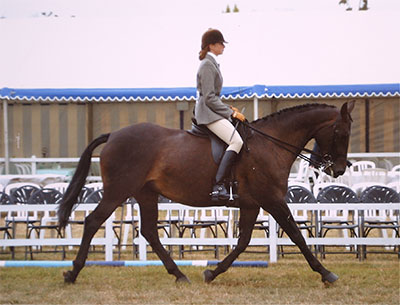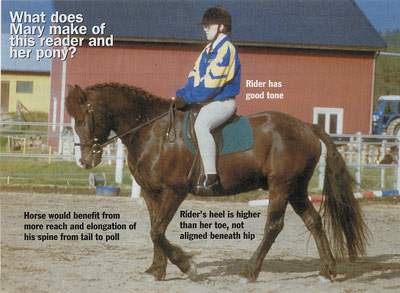RWYM
ARTICLE 10
 The horse shown in this photograph was owned by a friend of the rider. I do not know the horse’s age, but know that this partnership were only together for a very short time, and that the horse has just been sold. The parting has left her rider feeling the sadness that ‘we clicked and she had real potential, but it was not to be’.
The horse shown in this photograph was owned by a friend of the rider. I do not know the horse’s age, but know that this partnership were only together for a very short time, and that the horse has just been sold. The parting has left her rider feeling the sadness that ‘we clicked and she had real potential, but it was not to be’.
I think she is right, for the photograph suggests that they did ‘click’ and that the horse does indeed have some potential, even though light weight thoroughbreds (or near thoroughbreds, as I presume this horse is) are often not the most robust horses, either physically or mentally. However, I am a sucker for this kind of horse, and if you have the tact and subtlety to ‘click’ with a thoroughbred mare, you can have a wonderfully willing partner who will do anything for you. The downside is that they will rarely score well in dressage when pitted against Warmbloods, and they ideally need more size and substance to go eventing. Their forte is likely to be show jumping – although again, they need a big heart to overcome the limitations of their size.
There is a lot to like about this photograph, and in terms of rider biomechanics, the rider has unusually correct baselines. There is one fatal flaw, however, which is that the horse is so far from tracking up. The left hind, which is about to bear weight in the stance phase of the stride, will not be placed anywhere near the hoof print of the left fore. To say that the mare lacks impulsion is probably an understatement – she is taking pony-size steps.
We then have to wonder why this is, and there are many possible explanations. Perhaps the rider does not know it is happening, and perhaps she thinks that this is what working trot feels like. Perhaps the horse is one of the ‘walking wounded’ and is physically so compromised that this is all the movement she is capable of. Perhaps the rider is ‘playing safe’ possibly because of her own fears, or because she is concerned that she cannot ‘get it together’ so well on a more forward-going trot.
We can only guess at this, although I suspect that the last suggestion is the most probable. The rider looks as if she is too organised and knowledgeable to be conned by the pony-size steps, or to be afraid of the horse’s power. If the horse were physically compromised we would almost certainly be seeing more evasive patterns and more angst. So I suspect that the rider would prefer to ride this trot well than to risk that she and the horse will ‘fall to bits’ when they have more impulsion.
Going slowly in order to make it easy for you can be very tempting (especially in sitting trot), but the idea is to generate, contain, and work with the horse’s power, not to compromise and restrict that power. It can require deep breaths, all your courage, and the knowledge that if you do become more wobbly and disorganised as you ‘go for it’, it will not be the end of the world – especially if you can ride the less powerful trot as well as this rider can.
So let’s look at the positives. The rider is pictured at the top of the rise, and she has a very good balance over her feet. The acid test for this is that if we took her horse out from underneath her by magic, she would land on the riding arena on her feet. This is one of the key determinants of good rider biomechanics. She is managing this even though the stirrup appears to be under her toes rather than under the ball of her foot. The rider’s balance mimics the balance of a diver standing on a diving board about to do a backward dive, and it is clear that he would have difficulty if only his toes were resting on the board! Our rider is surviving the equivalent situation amazingly well, but I would advise both her and you to keep the ball of your foot resting on the stirrup. (I would also advise you to ride in a proper pair of riding boots and not your muckers. I think they have a heel, but am not sure that they look wonderfully safe.
There is a nice balance between the weight which goes down the rider’s thigh, and the weight which rests in the stirrup and her heel. This makes the thigh and the calf look like an arrowhead shape, with the knee at the point of the arrow. You can easily imagine two lines of force, one following her thighbone, and continuing down towards the horse’s advanced foreleg, and the other following the line of her calf, and aiming toward the horse’s advanced hind foot. It is the balance between these which holds the leg in place: with too much force (or weight) aimed down the thigh, and not enough aimed towards the heel, the foot goes backwards and the rider topples forward. With too much directed into the heel and not enough into the knee, the heel goes forward and the rider topples backward. So these forces need to be balanced, and within this, the foot rests rather than presses in the stirrup, just as the diver rests on the diving board (rather than creating the push down which then causes the board to push him up).This idea is one of the most important in my understanding of rider biomechanics.
The knee looks very stable – neither it nor the foot are going to wobble about as the rider rises and sits. You are seeing a good rising trot mechanism here, with the knee joint acting as the centre point of a circle, whilst the thigh bone acts like the radius of the circle and the pelvis rotates forward and back on a arc of that circle. Meanwhile, nothing from the knee down changes.
This is much different to the more common version of pushing into the stirrup and straightening your knee in every rise, which makes the lower leg swing forward each time. Sadly, you see this version of rising trot, with its poor rider biomechanics far too often. There are a number of reasons why it does not work so well (which I have discussed in previous articles), but I am fairly sure that the rider could maintain the benefits of her correct technique if she were brave enough to work the horse more powerfully.
The rider’s jacket hides her torso so completely that we have to guess at the shape of her back. It is not rounded, following the shape of her jacket, for if it were, she would be toppling backward, and unable to maintain such a light rein contact. Neither is she hollow backed, and she is, I think, pretty close to the ideal of ‘neutral spine’, in which the spinal curves are balanced. This alignment accounts for much of the rightness that you see here.
The horse is beginning to reach into the rein well, although there is more reaching to come before she is truly ‘on the bit’. Her back and wither will come up more, and her neck will lower more, maintaining that nice even curve from wither to poll, and the open angle under the gullet. It is very nice to see that the rider is obviously not pulling the horse’s head in and riding her ‘from front to back’. She has a very pleasing, correct line from her elbow, to her hand, to the horse’s mouth. But she has to capitalise more strongly on her existing skills in order to create more reaching into the rein, and more impulsion.












